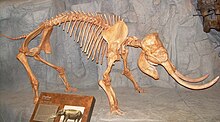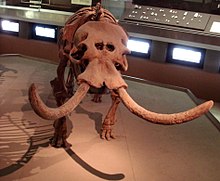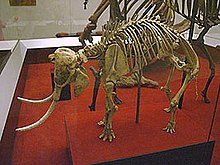Dwarf elephant

Dwarf elephants are prehistoric members of the order Proboscidea which, through the process of allopatric speciation on islands, evolved much smaller body sizes (around 1–2.3 metres (3 ft 3 in – 7 ft 7 in)) in comparison with their immediate ancestors. Dwarf elephants are an example of insular dwarfism, the phenomenon whereby large terrestrial vertebrates (usually mammals) that colonize islands evolve dwarf forms, a phenomenon attributed to adaptation to resource-poor environments and lack of predation and competition. Some modern populations of Asian elephants have also undergone size reduction on islands to a lesser degree, resulting in populations of pygmy elephants.
Fossil remains of dwarf elephants have been found on the Mediterranean islands of Cyprus, Malta (at Għar Dalam), Crete (in Chania at Vamos, Stylos and in a now-underwater cave on the coast), Sicily, Sardinia, the Cyclades Islands and the Dodecanese Islands, which are mostly members of the genus Palaeoloxodon, descending from the large 4 metres (13 ft) tall mainland European species Palaeoloxodon antiquus. Dwarf species of elephants and Stegodon have been found on the islands of Indonesia and the Philippines. The Channel Islands of California once supported a dwarf species descended from Columbian mammoths, while the woolly mammoths that existed on Wrangel Island north of Siberia were once considered dwarfs, but are not anymore.
The Mediterranean islands

Dwarf elephants first inhabited the Mediterranean islands during the Pleistocene, including all the major islands with the apparent exception of Corsica and the Balearics. Mediterranean dwarf elephants have generally been considered as members of the genus Palaeoloxodon, derived from the continental straight-tusked elephant, Palaeoloxodon antiquus (Falconer & Cautley, 1847), Syn.: Elephas antiquus. An exception is the dwarf Middle-Late Pleistocene Sardinian mammoth, Mammuthus lamarmorai (Major, 1883), the first endemic elephant of the Mediterranean islands recognized as belonging to the mammoth line. Mammuthus creticus from the Early Pleistocene of Crete, formerly considered a member of Palaeoloxodon, is now also considered to be a mammoth, and approaches the size of the smallest dwarf elephants.
During low sea levels, the Mediterranean islands were colonised again and again, giving rise, sometimes on the same island, to several species (or subspecies) of different body sizes. As the Ice Age came to an end, sea levels rose, stranding elephants on the island. The island of Sicily appears to have been colonised by proboscideans in at least three separate waves of colonisation. These endemic dwarf elephants were taxonomically different on each island or group of very close islands, like the Cyclades archipelago.
There are many uncertainties about the time of colonisation, the phylogenetic relationships and the taxonomic status of dwarf elephants on the Mediterranean islands. Extinction of the insular dwarf elephants has not been correlated with the arrival of humans to the islands. Furthermore, it has been suggested by the palaeontologist Othenio Abel in 1914, that the finding of skeletons of such elephants sparked the idea that they belonged to giant one-eyed monsters, because the center nasal opening was thought to be the socket of a single eye, and thus perhaps were, for example, the origin of the one-eyed Cyclopes of Greek mythology.
Italy and Malta

| Island | Taxon | Author |
|---|---|---|
| Sardinia | Mammuthus lamarmorai | ( Major, 1883) |
| Malta | Palaeoloxodon falconeri | ( Busk, 1869) |
| Palaeoloxodon mnaidriensis | ( Adams, 1874) | |
| Sicily | Palaeoloxodon falconeri | ( Busk, 1869) |
| Palaeoloxodon cf. mnaidriensis | ( Adams, 1874) |
Greece
Crete

| Island | Taxon | Author |
|---|---|---|
| Crete | Mammuthus creticus | ( Bate, 1907) |
| Palaeoloxodon creutzburgi | ( Kuss, 1965) |
Poulakakis and others proposed in 2002 to rename all the described specimens of larger size than Mammuthus creticus under the new subspecies name Elephas antiquus creutzburgi (Kuss, 1965). After DNA research, published in 2006, it has been proposed to rename Elephas (Palaeoloxodon) creticus into Mammuthus creticus (Bate, 1907). In a recent study of 2007, it was argued for the groundlessness of the theory by Poulakakis et al. in 2006, showing the weak points of that DNA research. However, morphological data is at least equivocal, and may also support placement in Mammuthus.
Mammuthus creticus is the earlier species known from the Early Pleistocene. It is the smallest mammoth and is among the smallest dwarf elephants known, with a shoulder height of about 1 metre (3.3 ft) and a weight of about 180 kilograms (400 lb). Palaeoloxodon creutzburgi from the Middle Pleistocene and Late Pleistocene is significantly larger, with an estimated body mass comparable to living Asian elephant, around 40% the size of its mainland ancestor.
Cyclades
| Island | Taxon | Author |
|---|---|---|
| Delos | Palaeoloxodon sp. | Vaufrey, 1929 |
| Naxos | Palaeoloxodon lomolinoi | Van der Geer et al., 2014 |
| Paros | Elephantidae indet. | Georgalas, 1929 |
| Kythnos | Elephantidae indet. | Honea, 1975 |
| Milos | Elephantidae indet. | Papp, 1953 |
| Serifos | Elephantidae indet. | Papp, 1953 |
Remains of paleoloxodontine elephants have been reported from several Cyclades islands. The Delos elephant's size is comparable to Palaeoloxodon mnaidriensis. The Naxos elephant has been described as Palaeoloxodon lomolinoi and it was smaller than the Delos elephant with a calculated body mass of only 10% of that of its mainland ancestor Palaeoloxodon antiquus.
Dodecanese
| Island | Taxon | Author |
|---|---|---|
| Astypalaia | Palaeoloxodon sp. | Athanassiou et al., 2019 |
| Kasos | Palaeoloxodon aff. creutzburgi | Sen et al., 2014 |
| Rhodes | Palaeoloxodon sp. | Symeonides et al., 1974 |
| Tilos | Palaeoloxodon tiliensis | ( Theodorou et al. 2007) |
On the island of Rhodes, bones of an endemic dwarf elephant have been discovered. This elephant was similar in size to Palaeoloxodon mnaidriensis.
Two groups of remains of dwarf elephants have been found on the island of Tilos. They are similar in size to Palaeoloxodon mnaidriensis and the smaller Palaeoloxodon falconeri, but the two groups indicate sexual dimorphism. The remains had originally been designated to Palaeoloxodon antiquus falconeri (Busk, 1867). However, this name refers to the dwarf elephants from the island of Malta. As a result, since no migration route between the two islands can be proven, this name should not be used when referring to the elephant remnants from Tilos. The species has been described as Elephas tiliensis in 2007 and it is now assigned to genus Palaeoloxodon.
The Tilos dwarf elephant is the first dwarf elephant whose DNA sequence has been studied. The results of this research are consistent with previous morphological reports, according to which Palaeoloxodon is more closely related to Elephas than to Loxodonta or Mammuthus. On the other hand, DNA analysis in 2017 conclude that the closest living relative of the genus Palaeoloxodon is the African forest elephant (Loxodonta cyclotis). The paper suggests that the current view of elephant evolution is "in need of substantial revision". After the study of new osteological material that has been excavated in anatomical connection in the Charkadio Cave on Tilos island the new species name Palaeoloxodon tiliensis has been assigned to the Tilos dwarf elephants.
The Tilos dwarf elephant is the only among the Mediterranean elephants that has been proven to have survived into the Holocene, with the most recent remains having been dated to just 3040-1840 BCE.
Cyprus
| Island | Taxon | Author |
|---|---|---|
| Cyprus | Palaeoloxodon cypriotes | ( Bate, 1903) |
| Palaeoloxodon xylophagou | Athanassiou et al., 2015 |
The Cyprus dwarf elephant survived at least until 11,000 BC. Its estimated body weight was only 200 kg (440 lb), only 2% of its 10,000 kg (22,000 lb) ancestor. Molars of this dwarf elephant are reduced to approximately 40% the size of mainland straight-tusked elephants.
Remains of the species were first discovered and recorded by Dorothea Bate in a cave in the Kyrenia hills of Cyprus in 1902 and reported in 1903.
The Channel Islands of California
The Columbian mammoth (Mammuthus columbi) produced a separate, isolated population at the end of the Pleistocene on the Channel Islands of California, most likely about 40,000 years ago (although the time of isolation is not fully known). Selective forces on the Channel Islands resulted in smaller animals, forming a new species, the pygmy mammoth (Mammuthus exilis). Channel Islands mammoths ranged from 150–190 cm (59–75 in) in shoulder height.
Wrangel Island
During the last ice age, woolly mammoths (Mammuthus primigenius) lived on Wrangel Island in the Arctic Ocean and survived until 1700 BC, the most recent survival of any known mammoth population. Wrangel Island is thought to have become separated from the mainland by 12000 BC. It was assumed that Wrangel Island mammoths ranged from 180–230 cm (71–91 in) in shoulder height and were for a time considered "dwarf mammoths". However this classification has been re-evaluated and since the Second International Mammoth Conference in 1999, these mammoths are no longer considered to be true "dwarf mammoths".
Indonesia and the Philippines
In Indonesia and the Philippines, evidence of a succession of distinct endemic island faunas has been found, including dwarfed elephants and species of Stegodon.
Flores

During the late Early Pleistocene, Flores was inhabited by the dwarf species Stegodon sondaarii, around 15% of the size of mainland Stegodon species, which was around 120 cm (3.9 ft) tall at the shoulder and weighed about 350–400 kilograms (770–880 lb). This species became extinct around 1 million years ago, being replaced by Stegodon florensis. Stegodon florensis shows a progressive size reduction with time, with the earlier Middle Pleistocene subspecies Stegodon florensis florensis estimated to be around 50% the size of mainland Stegodon species with a shoulder height of around 190 cm (6.2 ft) and a body mass of around 1.7 tons, while the later Stegodon florensis insularis from the Late Pleistocene is estimated to be around 17% the size of mainland Stegodon species, with a shoulder height of around 130 cm (4.3 ft), and a body mass of about 570 kilograms (1,260 lb) Stegodon florensis became extinct about 50,000 years ago, around the time of the arrival of modern humans to Flores.
Sulawesi
During the Late Pliocene-Early Pleistocene on Sulawesi, two species of dwarf proboscidean coinhabited the island, the elephant Stegoloxodon celebensis, and Stegodon sompoensis. The former was about 150 cm (4.9 ft) tall, while the latter was around 32% the size of mainland Stegodon species, with an estimated body mass of about a ton. Later in the Pleistocene, these animals were replaced by larger-sized species of Stegodon and elephants, with an indeterminate Stegodon species from the Middle Pleistocene of Sulawesi being around 57% the size of mainland species, with an estimated bodymass of about 2 tons.
Java
The species Stegodon trigonocephalus is known from the Early-Middle Pleistocene of Java. A population from the Trinil H.K locality, which likely dates to the Middle Pleistocene, is around 65% the size of mainland Stegodon species. Large individuals are estimated to have reached around 280 cm (9.2 ft) at the shoulders, with a body mass of around 5 tons. Other smaller unnamed Stegodon species are also known from the Early Pleistocene on the island. The extinct dwarf elephant species Stegoloxodon indonesicus is also known from the Early Pleistocene of Java, which is probably closely related to S. celebensis from Sulawesi, but whose relationships to other elephants are obscure.
Sumba
The species Stegodon sumbaensis of an uncertain Middle-Late Pleistocene age from Sumba is one the smallest known species, at around 8% of the size of its mainland ancestor, with an estimated body mass of around 250 kilograms (550 lb).
Timor
The species S. timorensis is known from the Middle Pleistocene of Timor. It is a small-sized species, only slightly larger than S. sondaarii, and around 23% the size of mainland species, with an estimated body mass of around 770 kilograms (1,700 lb).
Luzon
On Luzon the dwarf Stegodon luzonensis is known from remains found in the Manila Basin of an uncertain Pleistocene age, as well as remains found near the early Middle Pleistocene Nesorhinus butchery site. It is around 40% the size of mainland Stegodon species, with a body mass of around 1.3 tons. The extinct dwarf elephant Elephas beyeri is also known from the island, which is estimated to have been about 1.2 metres (3.9 ft) in shoulder height.
Mindanao
On the island of Mindanao, the dwarf Stegodon species Stegodon mindanensis was present at some point in the Pleistocene. It has an estimated body mass of around 400 kilograms (880 lb).